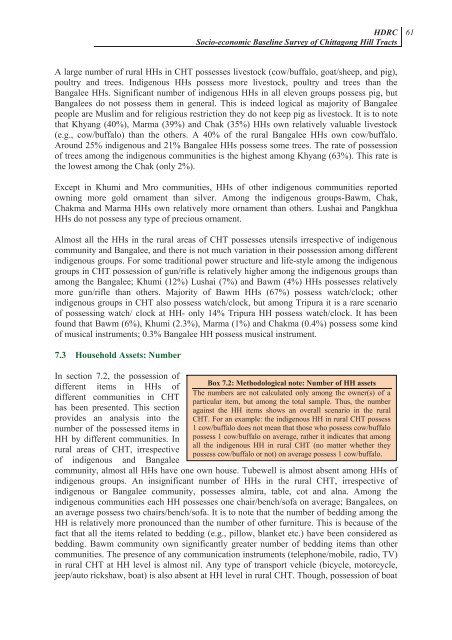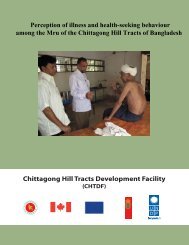Socio-economic Baseline Survey of Chittagong Hill Tracts - chtdf
Socio-economic Baseline Survey of Chittagong Hill Tracts - chtdf
Socio-economic Baseline Survey of Chittagong Hill Tracts - chtdf
- No tags were found...
You also want an ePaper? Increase the reach of your titles
YUMPU automatically turns print PDFs into web optimized ePapers that Google loves.
HDRC<strong>Socio</strong>-<strong>economic</strong> <strong>Baseline</strong> <strong>Survey</strong> <strong>of</strong> <strong>Chittagong</strong> <strong>Hill</strong> <strong>Tracts</strong>61A large number <strong>of</strong> rural HHs in CHT possesses livestock (cow/buffalo, goat/sheep, and pig),poultry and trees. Indigenous HHs possess more livestock, poultry and trees than theBangalee HHs. Significant number <strong>of</strong> indigenous HHs in all eleven groups possess pig, butBangalees do not possess them in general. This is indeed logical as majority <strong>of</strong> Bangaleepeople are Muslim and for religious restriction they do not keep pig as livestock. It is to notethat Khyang (40%), Marma (39%) and Chak (35%) HHs own relatively valuable livestock(e.g., cow/buffalo) than the others. A 40% <strong>of</strong> the rural Bangalee HHs own cow/buffalo.Around 25% indigenous and 21% Bangalee HHs possess some trees. The rate <strong>of</strong> possession<strong>of</strong> trees among the indigenous communities is the highest among Khyang (63%). This rate isthe lowest among the Chak (only 2%).Except in Khumi and Mro communities, HHs <strong>of</strong> other indigenous communities reportedowning more gold ornament than silver. Among the indigenous groups-Bawm, Chak,Chakma and Marma HHs own relatively more ornament than others. Lushai and PangkhuaHHs do not possess any type <strong>of</strong> precious ornament.Almost all the HHs in the rural areas <strong>of</strong> CHT possesses utensils irrespective <strong>of</strong> indigenouscommunity and Bangalee, and there is not much variation in their possession among differentindigenous groups. For some traditional power structure and life-style among the indigenousgroups in CHT possession <strong>of</strong> gun/rifle is relatively higher among the indigenous groups thanamong the Bangalee; Khumi (12%) Lushai (7%) and Bawm (4%) HHs possesses relativelymore gun/rifle than others. Majority <strong>of</strong> Bawm HHs (67%) possess watch/clock; otherindigenous groups in CHT also possess watch/clock, but among Tripura it is a rare scenario<strong>of</strong> possessing watch/ clock at HH- only 14% Tripura HH possess watch/clock. It has beenfound that Bawm (6%), Khumi (2.3%), Marma (1%) and Chakma (0.4%) possess some kind<strong>of</strong> musical instruments; 0.3% Bangalee HH possess musical instrument.7.3 Household Assets: NumberIn section 7.2, the possession <strong>of</strong>different items in HHs <strong>of</strong>different communities in CHThas been presented. This sectionprovides an analysis into thenumber <strong>of</strong> the possessed items inHH by different communities. Inrural areas <strong>of</strong> CHT, irrespective<strong>of</strong> indigenous and BangaleeBox 7.2: Methodological note: Number <strong>of</strong> HH assetsThe numbers are not calculated only among the owner(s) <strong>of</strong> aparticular item, but among the total sample. Thus, the numberagainst the HH items shows an overall scenario in the ruralCHT. For an example: the indigenous HH in rural CHT possess1 cow/buffalo does not mean that those who possess cow/buffalopossess 1 cow/buffalo on average, rather it indicates that amongall the indigenous HH in rural CHT (no matter whether theypossess cow/buffalo or not) on average possess 1 cow/buffalo.community, almost all HHs have one own house. Tubewell is almost absent among HHs <strong>of</strong>indigenous groups. An insignificant number <strong>of</strong> HHs in the rural CHT, irrespective <strong>of</strong>indigenous or Bangalee community, possesses almira, table, cot and alna. Among theindigenous communities each HH possesses one chair/bench/s<strong>of</strong>a on average; Bangalees, onan average possess two chairs/bench/s<strong>of</strong>a. It is to note that the number <strong>of</strong> bedding among theHH is relatively more pronounced than the number <strong>of</strong> other furniture. This is because <strong>of</strong> thefact that all the items related to bedding (e.g., pillow, blanket etc.) have been considered asbedding. Bawm community own significantly greater number <strong>of</strong> bedding items than othercommunities. The presence <strong>of</strong> any communication instruments (telephone/mobile, radio, TV)in rural CHT at HH level is almost nil. Any type <strong>of</strong> transport vehicle (bicycle, motorcycle,jeep/auto rickshaw, boat) is also absent at HH level in rural CHT. Though, possession <strong>of</strong> boat



